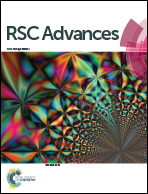CO2-responsive self-healable hydrogels based on hydrophobically-modified polymers bridged by wormlike micelles†
Abstract
CO2-responsive hydrogels, using CO2 as a “green” trigger, have recently been of considerable interest. Herein, a novel CO2-responsive self-healable hydrogel is fabricated by simply mixing hydrophobically modified polyacrylamide (HMPAM) with sodium dodecyl sulfate (SDS)–N,N,N′,N′-tetramethyl-1,3-propanediamine (TMPDA) surfactant micelles. In the presence of CO2, the SDS–TMPDA spherical micelles transform into long wormlike micelles, serving as multivalent cross-linkages to bridge HMPAM chains based on hydrophobic interactions. The interpenetrating three-dimensional network induces a sol-to-gel transition, accompanied by a 360 and 400 times enhancement of the zero-shear viscosity and storage modulus, G′ (ω = 6.28 rad s−1), respectively. In additon, the sol–gel transition can be repeatedly and reversibly switched by cyclically bubbling and removing CO2 without any harm. Furthermore, the CO2-responsive hydrogel exhibits significant shear-thinning and self-healing properties, suggesting that the hydrogel is injectable and could be used as a potential plug to block CO2 gas breakthrough channels during CO2 flooding. Therefore, we believe that the presented work will enable the development of the design of CO2-responsive self-healable hydrogels and their practical applications.



 Please wait while we load your content...
Please wait while we load your content...